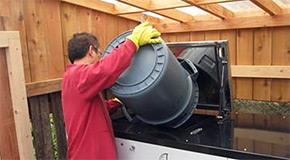 Recycle food scraps at your building or business on-site with organics management systems
Recycle food scraps at your building or business on-site with organics management systems

On-site organics management systems turn food scraps into compost, energy, or dehydrated organic material.
Using these systems at your multi-unit residential building or business can save you money on waste disposal fees and create soil conditioners for landscaping.
Is it right for your building?
Take this short quiz to see if on-site organics management suits your building or office.
- Do owners, strata councils, property managers, caretakers, tenants, and workers support setting up an on-site organics management system?
- Are there any recycling enthusiasts or building tenants willing to coordinate and manage the system?
- Does your building or business generate food scraps, yard trimmings, or other materials that can go into the system?
- Do you have space to install an on-site system so that all building users can access it?
- Do you have use for compost, biogas, or other end products?
If you answered:
- Yes or maybe to four or more questions, you may be suited for an on-site organics management system. Explore the questions below to help you plan for a system at your property.
- No to two or more questions, you are better off hiring a private waste hauler to collect your food scraps and yard waste.
- Find a food scraps hauler and get helpful screening questions
Plan for on-site organics management
To help you plan, research the following questions.
Manage your compostable materials
- Does your building have a collection program for food scraps, yard waste, and other compostable materials? If so, does the program's capacity meet your needs?
- Have you considered other ways to keep food scraps from the garbage, like donating excess edible food or using de-packaging services?
Buy and install the system
- Is the system you want available to buy?
- Is there space to install the system?
- Will the space be:
- On a flat surface, like a concrete pad?
- Connected to power (depends on the system), water, and sewer?
- Ventilated?
- Covered, if the system is outdoors?
- Protected against fires, odours, and pests?
- Who will install the system and how long will it take?
- Is an electrical permit, wastewater discharge permit, or solid waste licence needed to install and operate the system?
- What is the cost to ship, get permits and licences for, install, operate, and maintain the system?
Operate the system and train users
- Was an on-site composting system used before? If it was discontinued, how come and what lessons were learned?
- How much compostable material will your building or business generate? What types? How frequently? Is there enough to always feed the system?
- Can the system process the volume, type, and frequency of compostable materials generated on-site? If the system can't handle certain types of materials, will you hire a food scraps hauler to collect them?
- Does the system need additional material to create its end product that you don't have on-site? If so, can you get this material easily?
- How much time and labour is needed to manage the system? Have you budgeted for this?
- How will building users be trained to use the on-site composting system?
- What support will the distributor or manufacturer provide?
- What is your backup plan to keep food scraps from the garbage if the system needs repairs?
Store and use the end product
- How long does the system take to turn compostable materials into its end product?
- Is the end product ready for use or does it need further processing, on-site or off-site, beforehand?
- Does your building have a use for the end product? If no, where else?
- Does your building have space to store end product for later use?
Learn how the systems are used
Multi-unit residential buildings: Read the publication "Metro Vancouver On-Site Composting Technology Review (Oct 2012)" on Metro Vancouver's website.
All types of buildings: See local examples of on-site organics management systems.